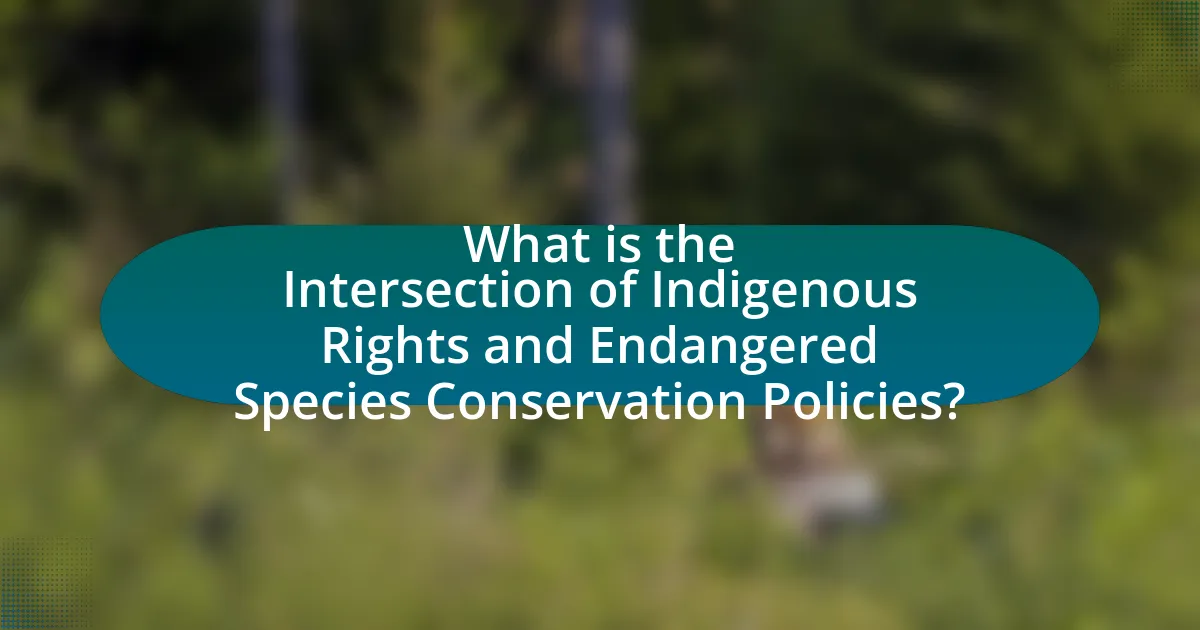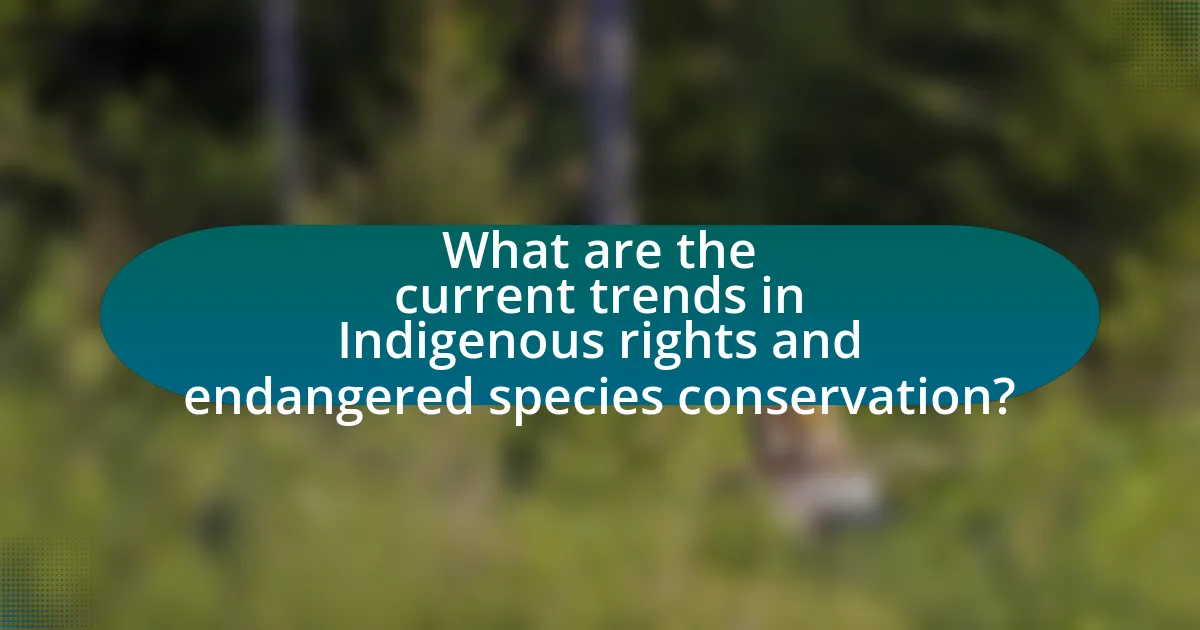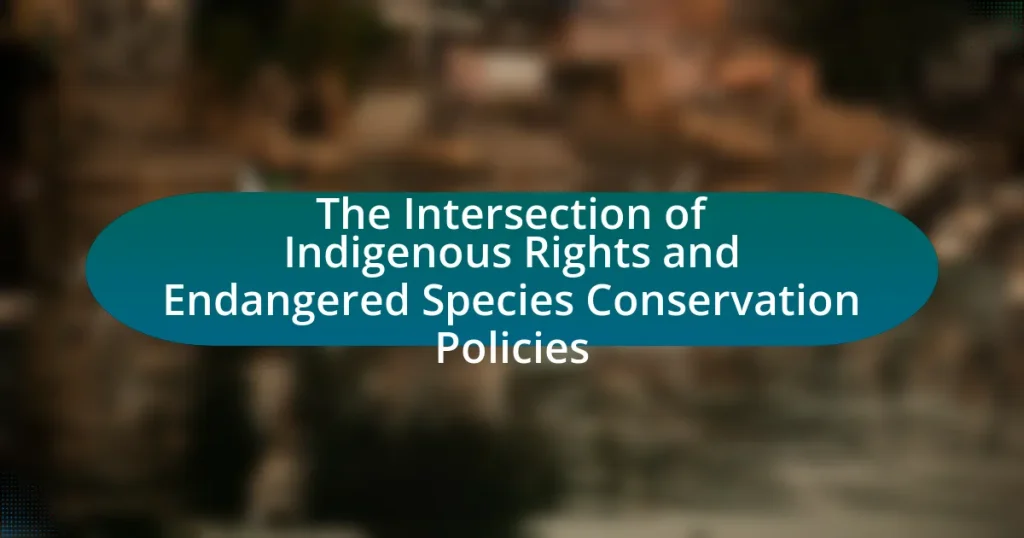The article examines the intersection of Indigenous rights and endangered species conservation policies, emphasizing the importance of recognizing Indigenous peoples’ rights to land and resources in conservation strategies. It highlights how Indigenous communities’ traditional ecological knowledge can enhance biodiversity management, as demonstrated by successful initiatives like the Indigenous Guardians program in Canada. Key principles such as self-determination, traditional land ownership, and the right to free, prior, and informed consent are discussed, along with the challenges faced in integrating these rights into conservation efforts. The article also explores the benefits of collaboration between Indigenous communities and conservationists, showcasing examples of successful partnerships and the impact of legal frameworks on Indigenous rights in conservation contexts.

What is the Intersection of Indigenous Rights and Endangered Species Conservation Policies?
The intersection of Indigenous rights and endangered species conservation policies involves the recognition of Indigenous peoples’ rights to land and resources while implementing conservation strategies. Indigenous communities often possess traditional ecological knowledge that can enhance conservation efforts, as seen in various case studies where Indigenous-led initiatives have successfully protected endangered species. For instance, the Indigenous Guardians program in Canada demonstrates how Indigenous stewardship can lead to improved biodiversity outcomes, highlighting the effectiveness of integrating Indigenous rights into conservation frameworks. This collaboration not only respects Indigenous sovereignty but also contributes to the sustainability of ecosystems, as evidenced by the positive impacts on species recovery in areas managed by Indigenous groups.
How do Indigenous rights relate to conservation efforts?
Indigenous rights are fundamentally linked to conservation efforts as they recognize the traditional knowledge and stewardship practices of Indigenous peoples, which are crucial for effective biodiversity management. Research indicates that Indigenous lands often harbor a significant portion of the world’s biodiversity; for instance, Indigenous territories cover about 22% of the Earth’s surface and contain 80% of its remaining biodiversity. This connection underscores the importance of integrating Indigenous rights into conservation policies to enhance ecological outcomes and respect cultural heritage. Furthermore, studies show that when Indigenous communities are involved in conservation initiatives, such as the co-management of protected areas, there is a higher success rate in achieving conservation goals, demonstrating that Indigenous rights and conservation efforts are mutually reinforcing.
What are the key principles of Indigenous rights in relation to land and resources?
The key principles of Indigenous rights in relation to land and resources include self-determination, recognition of traditional land ownership, and the right to free, prior, and informed consent. Self-determination allows Indigenous peoples to govern themselves and make decisions regarding their lands and resources. Recognition of traditional land ownership acknowledges the historical and cultural connections Indigenous communities have with their territories, often supported by legal frameworks such as the United Nations Declaration on the Rights of Indigenous Peoples (UNDRIP). The right to free, prior, and informed consent ensures that Indigenous communities must be consulted and agree to any projects affecting their lands and resources, reinforcing their autonomy and protecting their interests. These principles are essential for safeguarding Indigenous cultures and promoting sustainable resource management.
How do these principles influence conservation policies?
Indigenous rights principles significantly influence conservation policies by integrating traditional ecological knowledge and promoting collaborative management practices. These principles advocate for the recognition of Indigenous peoples’ rights to land and resources, which leads to more effective conservation outcomes. For instance, studies have shown that areas managed by Indigenous communities often exhibit higher biodiversity and better ecosystem health compared to those managed solely by governmental entities. This is evidenced by the success of Indigenous-led initiatives in places like Canada and Australia, where Indigenous stewardship has resulted in the recovery of endangered species and habitats.
What are the main challenges at this intersection?
The main challenges at the intersection of Indigenous rights and endangered species conservation policies include conflicting land use priorities, cultural preservation issues, and governance disparities. Conflicting land use priorities arise when conservation efforts restrict Indigenous access to traditional lands, impacting their livelihoods and cultural practices. Cultural preservation issues emerge as conservation policies may not adequately consider Indigenous knowledge systems and practices, which are vital for biodiversity management. Governance disparities exist when Indigenous communities are excluded from decision-making processes regarding conservation policies, leading to a lack of representation and respect for their rights. These challenges highlight the need for inclusive frameworks that integrate Indigenous perspectives into conservation strategies.
What conflicts arise between Indigenous communities and conservation initiatives?
Conflicts between Indigenous communities and conservation initiatives primarily arise from differing priorities regarding land use and resource management. Indigenous communities often prioritize their traditional land rights, cultural practices, and subsistence needs, while conservation initiatives typically focus on protecting biodiversity and ecosystems, sometimes leading to restrictions on land access and resource exploitation. For instance, the establishment of protected areas can displace Indigenous peoples or limit their ability to engage in traditional hunting, fishing, and gathering practices, as seen in various cases globally, such as the conflict over the creation of national parks in the United States that affected Native American tribes. These tensions highlight the need for inclusive conservation strategies that respect Indigenous rights and integrate their knowledge and practices into conservation efforts.
How do legal frameworks impact Indigenous rights in conservation contexts?
Legal frameworks significantly impact Indigenous rights in conservation contexts by either recognizing or undermining their land and resource management practices. For instance, laws such as the United Nations Declaration on the Rights of Indigenous Peoples (UNDRIP) affirm Indigenous peoples’ rights to participate in decision-making processes regarding conservation efforts affecting their territories. Conversely, national laws that prioritize state control over land can marginalize Indigenous communities, limiting their ability to engage in sustainable practices that have historically preserved biodiversity. Evidence shows that when legal frameworks incorporate Indigenous rights, conservation outcomes improve, as seen in the case of co-management agreements in Canada, which have led to better protection of endangered species while respecting Indigenous stewardship.

Why is the collaboration between Indigenous communities and conservationists important?
The collaboration between Indigenous communities and conservationists is important because it combines traditional ecological knowledge with scientific conservation practices, leading to more effective environmental stewardship. Indigenous communities possess deep-rooted knowledge of local ecosystems, which can enhance conservation strategies and improve biodiversity outcomes. For instance, studies have shown that areas managed by Indigenous peoples often exhibit higher levels of biodiversity compared to those under conventional management, as seen in the work of the Indigenous Protected and Conserved Areas initiative in Canada, which emphasizes the role of Indigenous governance in conservation efforts. This partnership not only respects Indigenous rights but also fosters sustainable practices that benefit both the environment and local communities.
What benefits can arise from Indigenous involvement in conservation policies?
Indigenous involvement in conservation policies can lead to enhanced biodiversity and more effective ecosystem management. Indigenous communities possess traditional ecological knowledge that has been developed over generations, allowing them to understand local ecosystems deeply. For instance, studies have shown that areas managed by Indigenous peoples often exhibit higher levels of biodiversity compared to those managed by non-Indigenous entities. This is evidenced by research published in the journal “Nature” which indicates that Indigenous-led conservation initiatives can result in improved habitat preservation and species recovery rates. Furthermore, integrating Indigenous perspectives into conservation policies fosters social equity and respects Indigenous rights, which can lead to stronger community support for conservation efforts.
How does Indigenous knowledge contribute to effective conservation strategies?
Indigenous knowledge contributes to effective conservation strategies by integrating traditional ecological practices with contemporary scientific methods. This knowledge encompasses a deep understanding of local ecosystems, species behavior, and sustainable resource management, often developed over generations. For example, Indigenous land management practices, such as controlled burns, have been shown to enhance biodiversity and reduce wildfire risks, as evidenced by studies in Australia where Indigenous fire management has led to healthier landscapes and improved habitat for endangered species. Furthermore, Indigenous communities often prioritize the preservation of biodiversity for cultural and spiritual reasons, aligning conservation efforts with local values and fostering community engagement. This holistic approach not only enhances ecological outcomes but also supports the rights and livelihoods of Indigenous peoples, making conservation strategies more inclusive and effective.
What examples exist of successful collaborations between Indigenous peoples and conservation organizations?
Successful collaborations between Indigenous peoples and conservation organizations include the partnership between the Indigenous-led organization, the Kuku Yalanji people, and the Australian government in the Daintree Rainforest. This collaboration resulted in the establishment of the Kuku Yalanji Indigenous Protected Area, which protects biodiversity while respecting Indigenous land rights. Another example is the collaboration between the Sámi people and the Norwegian government, where traditional reindeer herding practices are integrated into conservation strategies for the Arctic ecosystem, demonstrating the effectiveness of Indigenous knowledge in managing natural resources. These partnerships highlight the importance of Indigenous stewardship in conservation efforts, leading to improved ecological outcomes and the recognition of Indigenous rights.
How can Indigenous rights be integrated into conservation policies?
Indigenous rights can be integrated into conservation policies by recognizing and incorporating Indigenous knowledge, governance systems, and land rights into the decision-making processes. This integration ensures that Indigenous communities have a meaningful role in the management and protection of their ancestral lands and resources, which is supported by the United Nations Declaration on the Rights of Indigenous Peoples (UNDRIP). For instance, studies have shown that Indigenous-led conservation initiatives, such as those in Canada and Australia, lead to more effective biodiversity outcomes due to the deep ecological knowledge and sustainable practices that Indigenous peoples possess. By formalizing partnerships with Indigenous communities and respecting their rights, conservation policies can achieve greater ecological and social justice.
What frameworks exist for incorporating Indigenous perspectives in policy-making?
Frameworks for incorporating Indigenous perspectives in policy-making include the United Nations Declaration on the Rights of Indigenous Peoples (UNDRIP), the Indigenous Knowledge Framework, and co-management agreements. UNDRIP provides a global standard for the recognition of Indigenous rights, emphasizing the importance of free, prior, and informed consent in decision-making processes. The Indigenous Knowledge Framework integrates traditional ecological knowledge into environmental policy, ensuring that Indigenous voices are included in conservation efforts. Co-management agreements, often established between Indigenous communities and governmental bodies, facilitate shared governance of natural resources, allowing for collaborative decision-making that respects Indigenous rights and knowledge. These frameworks collectively enhance the representation of Indigenous perspectives in policy-making, particularly in areas related to conservation and resource management.
How can stakeholders ensure equitable participation of Indigenous communities?
Stakeholders can ensure equitable participation of Indigenous communities by actively involving them in decision-making processes related to conservation policies. This involvement should include recognizing Indigenous rights, incorporating traditional ecological knowledge, and ensuring that Indigenous voices are heard and respected in policy development. For instance, the United Nations Declaration on the Rights of Indigenous Peoples emphasizes the importance of free, prior, and informed consent, which mandates that Indigenous communities must be consulted before any projects affecting their lands are initiated. Additionally, studies have shown that when Indigenous communities are engaged in conservation efforts, such as the case of the Great Bear Rainforest in Canada, biodiversity outcomes improve, demonstrating the effectiveness of their participation.

What are the current trends in Indigenous rights and endangered species conservation?
Current trends in Indigenous rights and endangered species conservation emphasize collaborative governance and the recognition of Indigenous knowledge in conservation efforts. Indigenous communities are increasingly being integrated into decision-making processes regarding land management and species protection, reflecting a shift towards co-management models. For instance, the United Nations Declaration on the Rights of Indigenous Peoples (UNDRIP) advocates for the rights of Indigenous peoples to participate in environmental governance, which has led to successful partnerships in various regions, such as the Great Bear Rainforest in Canada. These partnerships have shown that incorporating traditional ecological knowledge can enhance biodiversity conservation outcomes, as evidenced by studies indicating that areas managed by Indigenous peoples often exhibit higher levels of biodiversity.
How are global movements influencing local conservation policies?
Global movements are significantly influencing local conservation policies by promoting frameworks that prioritize indigenous rights and biodiversity protection. These movements, such as the global climate strikes and the Convention on Biological Diversity, advocate for the integration of traditional ecological knowledge into conservation strategies. For instance, the United Nations Declaration on the Rights of Indigenous Peoples emphasizes the importance of indigenous stewardship in managing natural resources, leading local governments to adopt policies that recognize and empower indigenous communities in conservation efforts. This shift is evidenced by the increasing number of local policies that incorporate indigenous land management practices, which have been shown to enhance biodiversity and ecosystem resilience, as reported in studies by the World Resources Institute.
What role do international agreements play in shaping Indigenous rights?
International agreements play a crucial role in shaping Indigenous rights by establishing legal frameworks that recognize and protect these rights on a global scale. For instance, the United Nations Declaration on the Rights of Indigenous Peoples (UNDRIP), adopted in 2007, outlines the rights of Indigenous peoples to self-determination, land, and resources, influencing national laws and policies. Additionally, international treaties, such as the Convention on Biological Diversity, emphasize the importance of Indigenous knowledge in conservation efforts, thereby integrating Indigenous rights into environmental governance. These agreements provide a platform for Indigenous voices, ensuring their participation in decision-making processes that affect their lands and cultures, ultimately reinforcing their rights and promoting sustainable practices.
How are Indigenous-led conservation initiatives gaining recognition?
Indigenous-led conservation initiatives are gaining recognition through increased collaboration with governmental and non-governmental organizations, as well as the integration of Indigenous knowledge into formal conservation strategies. This recognition is evidenced by the growing number of partnerships, such as the collaboration between Indigenous groups and the Canadian government, which aims to protect biodiversity while respecting Indigenous rights. Additionally, the United Nations Declaration on the Rights of Indigenous Peoples emphasizes the importance of Indigenous stewardship in environmental management, further legitimizing these initiatives. Studies show that areas managed by Indigenous communities often exhibit higher biodiversity levels, reinforcing the effectiveness of their conservation practices.
What practical steps can be taken to enhance the intersection of Indigenous rights and conservation?
To enhance the intersection of Indigenous rights and conservation, practical steps include recognizing and enforcing Indigenous land rights, integrating Indigenous knowledge into conservation practices, and fostering collaborative governance models. Recognizing Indigenous land rights ensures that Indigenous communities have legal authority over their ancestral territories, which has been shown to lead to better conservation outcomes, as evidenced by studies indicating that Indigenous-managed lands often have lower rates of deforestation and higher biodiversity. Integrating Indigenous knowledge into conservation practices allows for the incorporation of traditional ecological knowledge, which can improve the effectiveness of conservation strategies. Collaborative governance models, where Indigenous communities are active participants in decision-making processes, have been successful in various regions, demonstrating that when Indigenous peoples are involved, conservation efforts are more culturally relevant and sustainable.
What best practices should conservationists adopt when working with Indigenous communities?
Conservationists should prioritize collaboration and mutual respect when working with Indigenous communities. This involves actively engaging Indigenous peoples in decision-making processes regarding conservation efforts that affect their lands and resources. Research indicates that Indigenous knowledge systems can significantly enhance biodiversity conservation, as seen in studies like “Indigenous Knowledge and Biodiversity Conservation” published in the journal Conservation Biology, which highlights the effectiveness of integrating traditional ecological knowledge with scientific approaches. Additionally, conservationists should ensure that any conservation initiatives respect Indigenous rights and land tenure, as outlined in the United Nations Declaration on the Rights of Indigenous Peoples, which emphasizes the importance of obtaining free, prior, and informed consent. By adopting these best practices, conservationists can foster sustainable partnerships that benefit both biodiversity and Indigenous communities.
How can policymakers support the rights of Indigenous peoples in conservation efforts?
Policymakers can support the rights of Indigenous peoples in conservation efforts by ensuring their active participation in decision-making processes regarding land management and resource use. This involvement is crucial as Indigenous communities possess traditional ecological knowledge that can enhance conservation strategies. For instance, the United Nations Declaration on the Rights of Indigenous Peoples emphasizes the importance of obtaining free, prior, and informed consent from Indigenous communities before implementing conservation projects on their lands. Additionally, integrating Indigenous rights into national and international conservation policies can lead to more effective and equitable outcomes, as evidenced by successful co-management initiatives in various regions, such as the collaborative management of national parks in Australia, which have shown improved biodiversity outcomes while respecting Indigenous rights.


